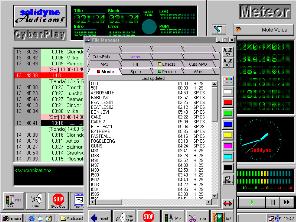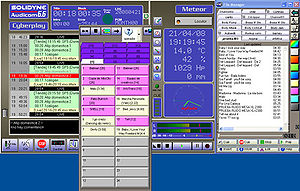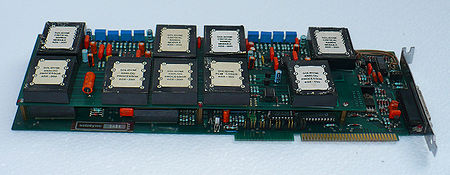
Audicom
Encyclopedia

Personal computer
A personal computer is any general-purpose computer whose size, capabilities, and original sales price make it useful for individuals, and which is intended to be operated directly by an end-user with no intervening computer operator...
-based broadcast automation
Broadcast automation
Broadcast automation incorporates the use of broadcast programming technology to automate broadcasting operations. Used either at a broadcast network, radio station or a television station, it can run a facility in the absence of a human operator...
system to use audio data compression technology based on psychoacoustics
Psychoacoustics
Psychoacoustics is the scientific study of sound perception. More specifically, it is the branch of science studying the psychological and physiological responses associated with sound...
.
The audio card was designed with standard CMOS logic ICs and used hardware to perform an audio data compression algorithm named ECAM, based on the critical bands masking principle, a property of the human ear. Today the same principle is used in all the lossy audio bit compression systems, MP3 included. The audio card was designed for the old ISA slots of the PC and works using direct memory access
Direct memory access
Direct memory access is a feature of modern computers that allows certain hardware subsystems within the computer to access system memory independently of the central processing unit ....
to the host memory. The driver and the client application were developed by Gustavo Pesci, while the hardware was designed by Ricardo Sidoti and Elio Demaria.
The radio automation
Broadcast automation
Broadcast automation incorporates the use of broadcast programming technology to automate broadcasting operations. Used either at a broadcast network, radio station or a television station, it can run a facility in the absence of a human operator...
system was launched in 1989 under the name Audicom. After 20 years, almost all the radio stations in the world are using some similar technology, now manufactured by a lot of companies around the world.
History of Audicom's software versions

Audicom II (1989): most popular version for DOS systems, exported to more than 30 countries. Introduced the concept of Playlist
Playlist
In its most general form, a playlist is simply a list of songs. They can be played in sequential or shuffled order. The term has several specialized meanings in the realms of radio broadcasting and personal computers.-In radio:...
for computer systems, and created the concept of Live Assist. When working in automatic mode, the music was selected from several directories with the /RANDOM command allowing the rotate styles along the day.
Audicom III & 4: not released, but developed internally. Audicom 4 was the first version intended to be a Windows version (for 16 bit Windows), but due to problems in the Win16 platform it was canceled in favor of a Win32 system (Audicom 5). The change (including staff change) caused a delay to the project of two years.
Audicom 5 (Introduced at CAPER 96, commercially available at 1997): first Windows system available. There were two versions (both Win32 applications): ECAM and multimedia. The multimedia version included the option of an 'audio co-processor card' (a compressor-expanser for greater dynamic range with conventional sound cards). New ECAM cards allowd to perform the mixing on the same card. Multimedia version used two cards for mixing and 3 cards for mix and cue (which was pretty hard to install on a same PC). The Audicom 5 introduced a novel concept of Artificial intelligence
Artificial intelligence
Artificial intelligence is the intelligence of machines and the branch of computer science that aims to create it. AI textbooks define the field as "the study and design of intelligent agents" where an intelligent agent is a system that perceives its environment and takes actions that maximize its...
for selecting music called AutoDJ, which allowed for '1 second precision' to meet the spots schedule on real time (the operator can add or remove titles and the autoDJ will meet the schedule without cut any music). Other novelty was the virtual locutor, which announces weather condition and time (based on a text to speech algorithm). A weather station was available as optional (SMT-100).
Audicom 6 (October 2000): Only a multimedia version. It introduced a new play engine based on DirectX, allowing mixing on the same audio card. First broadcasting audio system to support MP3
MP3
MPEG-1 or MPEG-2 Audio Layer III, more commonly referred to as MP3, is a patented digital audio encoding format using a form of lossy data compression...
, allowing cross-fade within two different MP3 files and CUE concurrently (all software decoding). The product was partnered with the PCI audio card SX46.
Audicom 7 (August 2002): Included multiuser support, network ready, included autoEdit (automatic editing of MP3's files without recompressing), full MP3 mixing. Also was partnered with an advanced PCI audio card: DSP48.
Modern systems for radio automation
In 1983 Oscar Bonello a radio automation pioneer, and Engineering professor at the University of Buenos Aires and Fellow of the AES (USA) start researching about using the recently developed IBM PC computer. The problems that he faced were: 1) Create an audio PC card of good audio quality; 2) Create a bit compression algorithm; 3) Create the Automation software to be run from the PC.The audio card was designed with standard CMOS logic ICs and perform by hardware the ECAM bit compression algorithm based on the principle of Critical Bands Masking a property of the ear (see a brief History at MP3 ). Today the same principle as the one used by Bonello is used in all the lossy audio bit compression systems, included MP3. The audio card was designed for the old ISA slots of the PC and works using direct access to PC memory. The driver for this software was developed by Gustavo Pesci, a young software engineer, formerly a pupil of Bonello at University. The card hardware was designed for Ricardo Sidoti and Elio Demaria, both brilliant electronic engineers.
The Radio Automation system was launched in 1987 under the name Audicom The software initially ran on DOS and was further changed by Sebastian Ledesma to Windows, using an Artificial Intelligence concept. Twenty years after the original Bonello invention, almost all the radio stations at the world use the same technology, now manufactured by various companies around the world. Mr Bonello refuses to apply for any type of invention patent.
Modern systems typically run on hard disk
Hard disk
A hard disk drive is a non-volatile, random access digital magnetic data storage device. It features rotating rigid platters on a motor-driven spindle within a protective enclosure. Data is magnetically read from and written to the platter by read/write heads that float on a film of air above the...
, where all of the music
Music
Music is an art form whose medium is sound and silence. Its common elements are pitch , rhythm , dynamics, and the sonic qualities of timbre and texture...
, jingle
Jingle
A jingle is a short tune used in advertising and for other commercial uses. The jingle contains one or more hooks and lyrics that explicitly promote the product being advertised, usually through the use of one or more advertising slogans. Ad buyers use jingles in radio and television...
s, advertisements, voice tracks and other announcements are stored. These computer file
Computer file
A computer file is a block of arbitrary information, or resource for storing information, which is available to a computer program and is usually based on some kind of durable storage. A file is durable in the sense that it remains available for programs to use after the current program has finished...
s may be either compressed
Data compression
In computer science and information theory, data compression, source coding or bit-rate reduction is the process of encoding information using fewer bits than the original representation would use....
or uncompressed, often with a minimal compression as a compromise
Compromise
To compromise is to make a deal where one person gives up part of his or her demand.In arguments, compromise is a concept of finding agreement through communication, through a mutual acceptance of terms—often involving variations from an original goal or desire.Extremism is often considered as...
.
Scheduling
Scheduling (broadcasting)
Broadcast programming or scheduling is the practice of organizing television shows or radio programs in a daily, weekly, or season-long schedule. Modern broadcasters use broadcast automation to regularly change the scheduling of their programs to build an audience for a new show, retain that...
was an important advance of these systems—allowing for exact timing. Some systems use GPS satellite
Satellite
In the context of spaceflight, a satellite is an object which has been placed into orbit by human endeavour. Such objects are sometimes called artificial satellites to distinguish them from natural satellites such as the Moon....
receivers
Receiver (radio)
A radio receiver converts signals from a radio antenna to a usable form. It uses electronic filters to separate a wanted radio frequency signal from all other signals, the electronic amplifier increases the level suitable for further processing, and finally recovers the desired information through...
to obtain exact atomic time, for perfect synchronization
Synchronization
Synchronization is timekeeping which requires the coordination of events to operate a system in unison. The familiar conductor of an orchestra serves to keep the orchestra in time....
with satellite-delivered
Communications satellite
A communications satellite is an artificial satellite stationed in space for the purpose of telecommunications...
programming
Radio programming
Radio programming is the Broadcast programming of a Radio format or content that is organized for Commercial broadcasting and Public broadcasting radio stations....
.
Automation systems are now more interactive than ever with digital
Digital
A digital system is a data technology that uses discrete values. By contrast, non-digital systems use a continuous range of values to represent information...
mixing console
Mixing console
In professional audio, a mixing console, or audio mixer, also called a sound board, mixing desk, or mixer is an electronic device for combining , routing, and changing the level, timbre and/or dynamics of audio signals. A mixer can mix analog or digital signals, depending on the type of mixer...
s and can even record
Recording
Recording is the process of capturing data or translating information to a recording format stored on some storage medium, which is often referred to as a record or, if an auditory medium, a recording....
from a telephone hybrid
Telephone hybrid
Telephone hybrids are an essential functional component of the Public Switched Telephone Network . The term also describes the piece of equipment used in broadcast facilities to enable the airing of telephone callers....
to play back an edited conversation
Conversation
Conversation is a form of interactive, spontaneous communication between two or more people who are following rules of etiquette.Conversation analysis is a branch of sociology which studies the structure and organization of human interaction, with a more specific focus on conversational...
with a telephone call
Telephone call
A telephone call is a connection over a telephone network between the calling party and the called party.-Information transmission:A telephone call may carry ordinary voice transmission using a telephone, data transmission when the calling party and called party are using modems, or facsimile...
er.
The simplest arrangements can even be done on software as basic as Winamp
Winamp
Winamp is a media player for Windows-based PCs and Android devices, written by Nullsoft, now a subsidiary of AOL. It is proprietary freeware/shareware, multi-format, extensible with plug-ins and skins, and is noted for its graphical sound visualization, playlist, and media library features.Winamp...
.
There is also a trend in radio to use voice-tracking
Voice-tracking
Voice-tracking, also called cyber jocking and referred to sometimes colloquially as a robojock, is a technique employed by some radio stations in radio broadcasting to produce the illusion of a live disc jockey or announcer sitting in the radio studios of the station when one is not actually...
production techniques which make the live presenter in the studio, less critical in the overall broadcast; a great number of Internet radio
Internet radio
Internet radio is an audio service transmitted via the Internet...
and variety hits stations use automation software and voice-tracking to completely replace live on-air talent
PC cards
The Audicom cards are a family of PC audio cards developed by Solidyne. They were intended to the broadcasting market and some models included the Audicom broadcasting system.
Models
- ADX 903
- ADX 922
- ADX 925
- ADX 925 Serie X
- SX 48
- SX 46
- DSP 48

